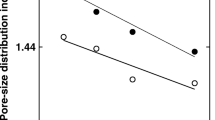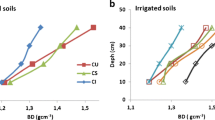Abstract
Due to urbanization, there is a large increase in industries; these industries produce effluent. This effluent will alter the physical and chemical characteristics of the soil and water. A laboratory study was attempted to understand its physiochemical change in soil and water through a column study: it was conducted under the variable head condition for two different soils (in situ and sandy soil) and four different wastewater samples (RO water, treated and untreated municipal water, untreated industrial wastewater) for one cycle. The time taken for sandy soil is 3 h, and for in situ soil, it is around 6 days. The pH, specific gravity, conductivity, permeability and shear strength properties were all studied. There was not much change in the chemical properties of the water upon passing it through the column medium. But the soil contaminated with untreated wastewater shows a reduction in bearing capacity by almost 50%, making it unfit for construction.









Similar content being viewed by others
References
Bhargava A, Lakmini S (2016) Land treatment as viable solution for waste water treatment and disposal in India. J Earth Sci Clim Change 7(11):1–5
Bouwer H, Chaney RL (1974) Land treatment of wastewater. Adv Agron 26(C):133–176
Bureau of Indian Standards (1975) Determination of dry density of soils In-place by the core-cutter method. IS 2720, vol Part XXIX
Bureau of Indian Standards (1981) Code of practice for determination of bearing capacity of shallow foundations (IS 6403:1981), p 24
Bureau of Indian Standards (1995) IS 2720 (Part IV) Grain size analysis, pp 1–40
Bureau of Indian Standards (2002) IS 1498-1970 (Reaffirmed 2002), pp 1–28
Bureau of Indian Standards (1997) IS 2720(Part III/2) Determination of specific gravity for fine, medium and coarse grained soil, vol 2720, pp 1–10
Central Bureau of Indian Standards (1986) IS 2720-XIII (Reaffirmed 2002), pp 1–17
Central Bureau of Indian Standards (2000) IS-14767_Electrical resistivity and conductivity_potassium, pp 1–7
Cheng L et al (2019) Soil physiochemical properties and landscape patterns control trace metal contamination at the urban-rural interface in southern China. Environ Pollut 250(1):537–545
Das R, Das SN (2003) Impact of wastewater discharge on soil and ground water—a case study. J Sci Ind Res (India) 62(3):207–211
Doorn MRJ, Towprayoon S, Irving W, Palmer C, Pipatti R (2006) Wastewater treatment and discharge, Guidelines for National Greenhouse Gas Inventories, Chap 6, pp 1–28
Elamathy M, Lavanya H, Nijandhan H, Dilip Kumar R, Nagarajan V, Sivapriya SV (2016) Impact of industrial effluents on soil. In: Indian geotechnical conference, Dec 2016, pp 15–18
IS 2720-17 (1986) Methods of test for soils, Part 17: laboratory determination of permeability [CED 43: Soil and Foundation Engineering]
IS: 3025 (Part 11) (1983) Methods of sampling and test for water and wastewater-pH value. BIS, New Delhi
Karmakar R, Das I, Dutta D, Rakshit A (2016) Potential effects of climate change on soil properties: a review. Sci Int 4(2):51–73
Mousavinezhad M, Rezazadeh M, Golbabae F, Seyedmahalleh ES (2015) Land treatment methods a review on available methods and its ability to remove pollutants. Orient J Chem 31(2):957–966
Paleolimnology JOF, Universit OH, Universit AL (2001) Loss on ignition as a method for estimating organic and carbonate content in sediments: reproducibility and comparability of results. J Paleolimnol 25(December):101–110
Shams KM, Tichy G, Sager M, Pee T, Bashar A, Jozic M (2009) Soil contamination from tannery wastes with emphasis on the fate and distribution of tri- and hexavalent chromium. Water Air Soil Pollut 199(1–4):123–137
Takeshi K (2000) Exposure assessment of chemical substances from soil and ground water environment. Shigen Kanyo 9(1):249–255
Acknowledgements
The authors would like to thank SSN College Management for providing facilities to carry out the experiments. The authors also thank Mr. K. Jegadheesan, laboratory instructor, for his help in fabricating the setup.
Author information
Authors and Affiliations
Corresponding author
Additional information
Editorial responsibility: R Saravanan.
Rights and permissions
About this article
Cite this article
Sivapriya, S.V., Rajagopalan, S., Duraimurugan, A. et al. Physiochemical properties of contaminated soil under the influence of industrial and municipal wastewater. Int. J. Environ. Sci. Technol. 17, 3715–3722 (2020). https://doi.org/10.1007/s13762-020-02717-w
Received:
Revised:
Accepted:
Published:
Issue Date:
DOI: https://doi.org/10.1007/s13762-020-02717-w




